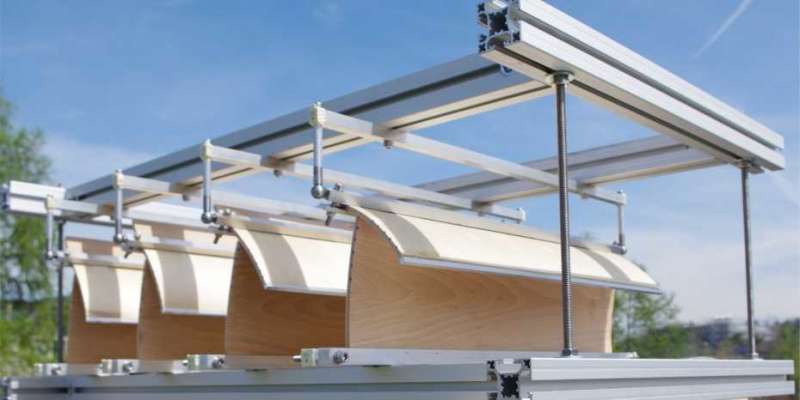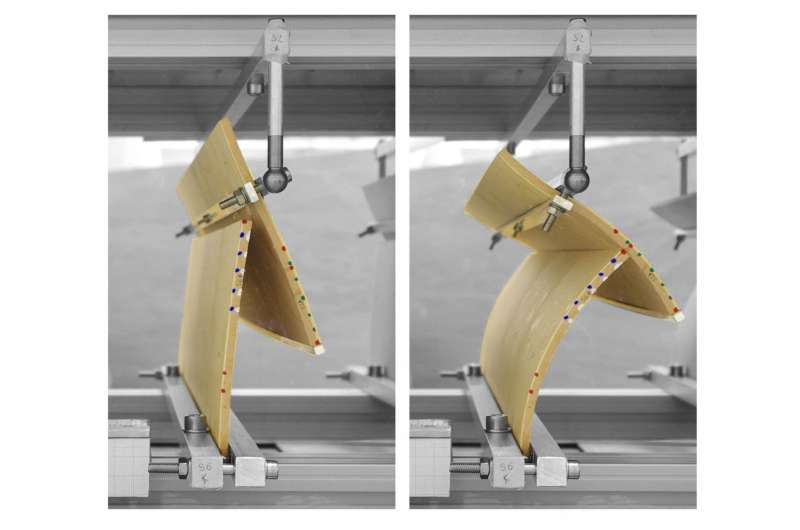From pine cones to an adaptive shading system

An adjustable shading system that adapts itself independently over the course of the day, without sensors or motors and largely maintenance-free? It really is possible: an ETH doctoral student at the Institute for Building Materials has developed an alternative to motor-driven sunshades.
It gets hot in the city in summer, and buildings in direct sunlight get particularly warm. At night, it can then be difficult to get rid of that accumulated heat. These days, many people dream of efficient air conditioning. Chiara Vailati had a different dream: after completing her studies in Italy, the civil engineer pursued the idea of creating an adjustable and autonomous sunshade for houses, to reduce the amount of heat that enters a building and therefore the need for cooling. She had high requirements: "I wanted the system to be made of environmentally friendly materials, use very little energy and have low installation and maintenance costs," remembers Vailati.
Vailati has since been able to realise her idea: during her doctoral project with Professor Ingo Burgert at ETH Zurich's Institute for Building Materials, she designed an innovative shading system. Anyone who is now picturing a fully automatic high-tech shading with sensors, actuators and complex controls is a long way off the mark. Vailati's prototype may be high-tech, but it is still refreshingly modest. The system uses shade-producing wooden planks and requires no sensors or motors – or even electricity. However, it does still change to suit to the weather conditions: the planks move autonomously. Multiple pairs of planks aligned in parallel create a kind of roof that opens and closes itself. The construction can be placed, for example, horizontally over a window on a building's façade.
"We were inspired by pinecones when it came to the autonomous movement of the planks," says Vailati. The scales of these cones react to changes in humidity: if the humidity decreases, the scales bend and move from a straight to a curved shape – so the cone opens in dry weather. It is the cone's structure that makes this possible: the scales consist of two connected layers that contract to different degrees as the humidity decreases.
Bilayered wood is a responsive material
Vailati transferred this operating principle to bilayered wooden planks. The layers consist of different kinds of wood, whose fibres are also oriented perpendicular to each other. It's a fascinating idea: "Like its natural model, the double layers of wood makes use of changes in humidity throughout the day," explains Vailati. In the humid morning air and at night, the planks are flat and vertical, while at midday, when the sun is high and the air is dryer, they bend noticeably and thus provide shade.

Alternative to motorised planks
This apparently simple idea required years of research. Vailati had to master two challenges in particular. Firstly, it was necessary to increase the initially very small bilayer structures to the standard plank length of half a meter, without the material deforming uncontrollably. Secondly, the system reacted too slowly compared to conventional motorised planks. "I had to find a way to accelerate the bilayer kinetics," says Vailati. Striped patterns in the wood and a finely adjusted ratio of layer thicknesses helped to speed up the movement. Finally, Vailati also made use of her experience as a civil engineer: to increase the amount of shade, she coupled the bilayered planks. "That significantly increased the reaction time," she says happily.
ETH Zurich patented her invention. And Vailati defended her doctoral thesis in February, and recently started work as a postdoc at Empa in the Building Energy Materials and components Group. A small prototype of her shading device can still be found on the roof of an ETH building on the Hönggerberg campus. Particularly on days like these its pleasantly cool shade would be blessing.
More information: C. Vailati et al. An autonomous shading system based on coupled wood bilayer elements, Energy and Buildings (2017). DOI: 10.1016/j.enbuild.2017.10.042
C. Vailati et al. Upscaling of wood bilayers: design principles for controlling shape change and increasing moisture change rate, Materials and Structures (2017). DOI: 10.1617/s11527-017-1117-4
Provided by ETH Zurich




















